Pictures of Soul
The inward gaze has its pictorial awakening in the work of Vincent van Gogh and Edward Munch. Not that artists had never taken a hard look at the self before, but few had attempted to penetrate its invisible, unspeakable uniqueness, despoiling it of connections to the external, operative world. What assumes form in van Gogh and Munch is the spiritual "aura," as it were, of the individual, qualitatively different self, its voiceless fears and aspirations, its struggle against forces bearing down upon it. The same thing occurs in the Urschrei, or primordial scream, of later expressionist poets: the first impetus for their labor is an encounter with anxiety. And its most celebrated example is Munch's The Scream .
The face of Munch's howling man on a bridge is almost bereft of features. His eyes and mouths are holes, as though nature had made these organs of perception and articulation dysfunctional out of malice. The man cups the ears of his hairless head with his hands, trying to block out the piercing sounds of the swirling, circumambient universe. Wandering away from dark, retreating figures impervious to this clash of abstract forces, he is witness to a nightmare outside himself. Internal though it be, his anguish is caused by cosmic pressure. If there is anything about this depiction that can be tied to debates about the "rights of the fetus," as some claimed when the painting was stolen during the winter Olympics in Norway, it is the suggestion that the actual life of this man is an abortion, and that he would have willingly refused such an indignity had he known, in the womb, what awaited him. The man is screaming about the monstrosity of the so-called right to life.
Munch's later Self-Portrait with a Cigarette (1895) shows a rigid man isolated from his background, facing a bright light illuminating his dazed and unseeing face. He has been caught by surprise; his startled and silent eyes show the passivity of an objectified subject. The smoke rising from his cigarette blends into the obscure and hazy background, while his torso fades away at the bottom of the frame; both reinforce the insubstantial, apparitional nature of the life in question. Something previously unseen comes into view in this apparitional life: an unfamiliar and impenetrable spirit that never developed out of it, now exposed to a light to whose warmth the subject is unaccustomed, like a creature of the shadows that he casts. His attempt to appear dignified in evening wear only makes the illuminated stress more clear.
In 1908 Munch suffers nervous collapse. During his treatment he paints a portrait of his doctor Daniel Jacobson (fig. 20). Everything in
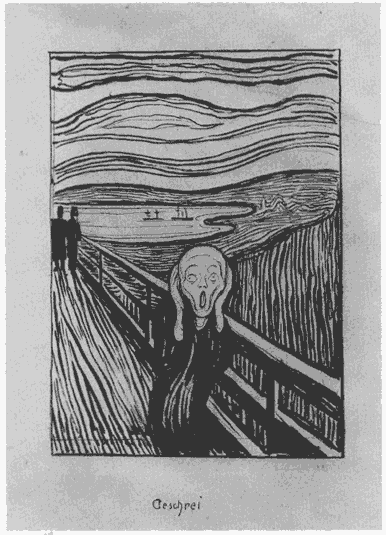
Fig. 19.
Edvard Munch, The Scream, © 1895, woodcut. Courtesy Munch Museum, Oslo.
this portrait conspires to convey an impression of the internal energy of the doctor: the towering, full-length view; the bursts of orange, green, red, and brown; the ethereal, dynamic movements of the space that he occupies with his arms akimbo. Whether these distortions of nature emanate from the doctor or are projected by the suffering patient's vision, the drama is an internal one. The resources of Munch's art are all geared
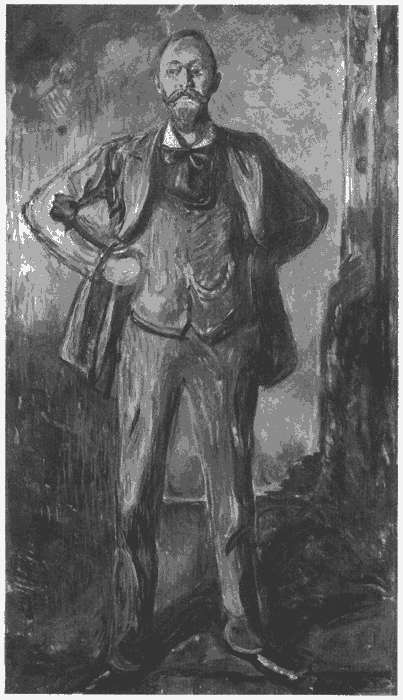
Fig. 20.
Edvard Munch, Portrait of Dr. Daniel Jacobsen, 1909, oil. Courtesy Munch Museum, Oslo.
toward uncovering what does not appear on the natural, objective surface of things, or what appears despite this surface.
The bridge between Munch and expressionist portraiture of 1910 is built by the artists who went by that name: Erich Heckel, Ernst Ludwig Kirchner, Karl Schmidt-Rottluff, and Fritz Bleyl, who announce the formation of the Brücke (Bridge) on June 7, 1905. Nourished on readings of Nietzsche and the vitalist philosophers, these young Germans make the pictorialization of the élan vital a programmatic objective. They associate much of this vitality with creative, libidinal energy, with sexuality, dance, and human communion. To express these spontaneous forces they emulate the "primitive," "elemental," and "instinctive" techniques of tribal art. By 1912 the exuberance of human subjectivity finds form not only in nudes but also in paintings of circus performers, artists at work, and music hail revelers. At the same time, the artists of the Brücke produce dramatic woodcuts of solitary faces, of figures set against metropolitan or natural contexts, many of them heroes and saints. In their view the "new human being" to whom they wished to provide a bridge would henceforth rely on the most intense, direct, and immediate forms of expression. "We claim as our own," writes Kirchner in a program of 1906, "everyone who reproduces directly and without falsification whatever it is that drives him to create" (Dube 1990: 21). Here the gaze in on oneself is intimately tied to ethical and aesthetic liberation. As the years go by, however, this liberation proves increasingly agonizing, leading to religious self-questioning on the part of the artists and, in the case of Kirchner, to suicide.
The generation of the Brücke was influenced not only by Munch and van Gogh but by the French Fauvists and Jugendstil, whose most interesting pictorial results lay in the work of Gustave Klimt. With their stunning blend of atomism, eroticism, and symbolism, Klimt's portraits always show links between figures and something that transcends them, whether it be mortality, languishing sexuality, an intricate, unreal surrounding, or the unwritten rules of social decorum. In the context of the towering influence of Klimt, it is ironic that the beginnings of Austrian, rather than German, expressionism are announced by an artist who refused to let his paintings be hung in the same room as the works of the master: Richard Gerstl.
Gerstl was a brilliant young artist who might have been more acclaimed had he not burned so many paintings before taking his life at the age of twenty-five. It all occurred at the end of 1908, after Gerstl had eloped with Schoenberg's wife, Mathilde. When Anton Webern
convinced Mathilde to return to her husband, Gerstl positioned himself in front of his atelier mirror, tightened a noose around his neck, and plunged a butcher knife into his chest. The importance of Gerstl lies largely with the emotional range and intensity of his portraits. One of them, notes Whitford (1981: 51), may be the first nude self-portrait since the sketch by Albrecht Dürer of 1503. Another shows the painter laughing at the spectator in demonic defiance. Both paintings glorify the subject as a shameless rebel. Whether their interest lies in self-analysis, however, or in parodying an image others might have of this self is hard to say. In either case the self-consciousness is ill at ease, inviting the audience to reflect on the mystery of a secret it is not disclosing. The true object of Gerstl's ironic laugh may be the futility of the hope of getting to the bottom of the self in question; for most of his portraits are of people who seem, like wraiths, "to be attempting to re-materialize in a world they have long since left" (Whitford 1981: 55). Indeed, in the Group Portrait of the Schoenberg family, Gerstl's brushstrokes and colors on the faces are so thick that "the identities of the subjects are all but obliterated" (Kallir 1984: 51). The members of this family lack the distinctive features by which we recognize persons. The self is Gerstl's subject, but it has become a conundrum.[12]
The two painters who do the most with the lead of Gerstl are Schiele and Oskar Kokoscha. Here, what is only implicit in van Gogh and Munch—though overexplicit in postwar expressionist painting—becomes a whole story: the dramatic efforts of a subject to come to expression. The drama is as clear in their portraits as in their self-portraits. In fact, at a certain point one cannot even distinguish between the two types of self in question. By his own confession, Kokoschka took to painting portraits in order to overcome "self-alienation" (Kokoschka 1974: 36–37). What he sought in ostensible representations of others was actually self-knowledge. The explanation for how the distinction between I and other is blurred by his art is addressed by his 1912 lecture on an issue that he calls das Bewusstsein der Gesichte : the consciousness of visions, or the imaginative apprehension of a face, where seer and seen are both subsumed in an act of seeing. The vision, countenance, or face (for Gesicht is simultaneously all three) is not simply a depiction of some "consciousness" or knowledge; it is an appearance that motivates consciousness. It is neither an objective image nor an artist's subjective im-
[12] On Gerstl's art, life, and relation to Schoenberg see Breicha 1991 and 1993; Kallir 1992; Schröder 1993.
pression, but a "stream" of understanding in which subjects and objects first receive their forms.[13] Consciousness of vision, claims Kokoschka's elusive essay, reproduces the functions of an oil lamp: the artist is a wick sucking up the oil provided by the aspects of others and then bursting into a flame of imagination. Consciousness of vision is not the form of an appearance, but consciousness of the form, or of appearance itself, a type of self-perception of that "nature, Gesicht, life" without which things have no form at all (Kokoschka 1912: 12). Vision-consciousness is Kokoschka's counterpart to the art of inner necessity in Kandinsky and the art of persuasion in Michelstaedter.[14] The "self" of which it speaks is one that has always already transcended itself.
Two works from 1909–1910 offer results of this consciousness of vision. One is a portrait of the architect Adolph Loos, the other of Herwarth Walden. Both faces are highlighted in a manner reminiscent of Munch's self-portrait of 1895, composed of jagged, almost animated layers of matter. The left eyes are surrounded by large rings of darker flesh, suggesting either an external bruise or the emanation of some energy deep inside the body. As frequently occurs in Kokoschka, the eyes speak of great spiritual distance from this body, a vision-consciousness transcending the medium through which it works. The distorted features of these two subjects—abstracted from every natural setting—not only suggest the oppression of consciousness by physical forces; they also suggest its rebellion against its palpable shapes (pictorially speaking: volume, line, color, gesture, and expression). What Schoenberg called the inborn and instinctive dimensions of the I, which have never
[13] If "two selves" are fused in Kokoschka's portraits one must also recognize a third—that of the person observing the painting, especially where its subject stares straight into his or her eyes, as occurs so often in expressionist portraits. These paintings interpolate the subjectivities of not only their sitters but also their viewers, as though asking, "Who are you to be shocked by the countenance you see? And what of your own case? Have you ever questioned your own self-vision?"
[14] In a defensive statement twenty years after the fact, Schoenberg upholds the "complete independence" of his paintings from those of Kokoschka, Gerstl, and Kandinsky (Schoenberg 1938). In the process he also sheds light on the distinctions within their conceptual vocabularies. Schoenberg recalls that he named his own paintings of 1910 "gazes" (Blicke ); Kandinsky later called them "visions" (Visionen ); Kokoschka spoke of his own paintings in terms of Gesicht (a word central also to Trakl; see Williams 1991: 153). Kokoschka's image of the artist as an oil lamp, fueled by a "superabundance of life," finds another link in Michelstaedter. On the title page of Persuasion and Rhetoric (which frequently describes persuasion as a process of transfiguring things into flames) Michelstaedter draws a lamp overflowing with oil. Next to a similar drawing in the margins of one of his books, he comments: "The lamp goes out because of lack of oil / I extinguished myself out of overflowing superbundance" (Michelstaedter 1975: 140–141). On Kokoschka's consciousness of vision, see Schorske 1981: 339–344. On Schoenberg's "gazes" see the essays in Schoenberg 1991b.
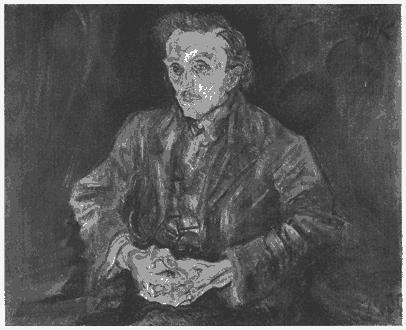
Fig. 21.
Oskar Kokoschka, Portrait of the Architect Adolf Loos, 1909, oil. Courtesy Bildarchiv
Preussischer Kulturbesitz, Berlin.
found adequate expression in history, can only lacerate the appearances they physically inherit. This laceration is even more severe in Kokoschka's self-portraits, particularly the poster for Der Sturm of 1910 (fig. 23). If the aim of Kokoschka's art is to overcome self-alienation, the cure lies in taking the disease to its extreme. The autoscopical self confesses to its own mutilation, its victimization, its inability to discover a true source of persuasion. At the same time this self has also left its body. In consciousness of vision, its eyes are outside; it exists in subjective transcendence. None of the "three selves" involved in the process of vision—the artist, the sitter, the viewer—is constituted except through this transcendent activity of seeing. No ontology of the I can be represented.
Schiele's portraits reveal a comparable search for an identity that cannot be portrayed. If people who commissioned their portraits from the young Austrian were frequently offended by the results (Otto Wagner was one), it had to do with the fact that they did not recognize themselves in the forms they were given. Like Kokoschka, Schiele exaggerated their features, making them look older or more pained than they
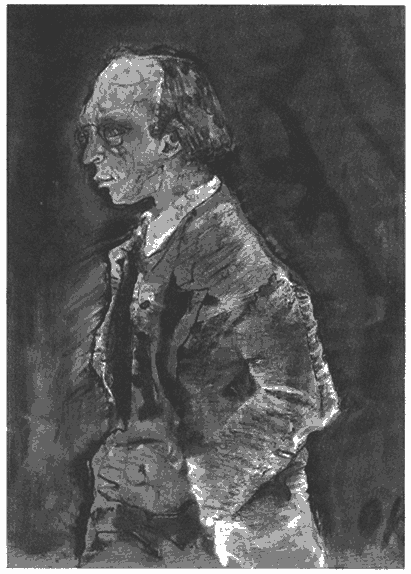
Fig. 22.
Oskar Kokoschka, Portrait of Herwarth Walden, 1910, oil. Courtesy Staatsgalerie Stuttgart.
were. In 1910 and 1911 he isolates his subjects from natural and imaginative settings. The atmospheric backgrounds of Gerstl, Kokoschka, and Max Oppenheim disappear, leaving only an emptiness from which the subject stands sharply out, sometimes isolated by the shielding margin of a halo. The "expressive solid inserted into a void" (Comini 1974:
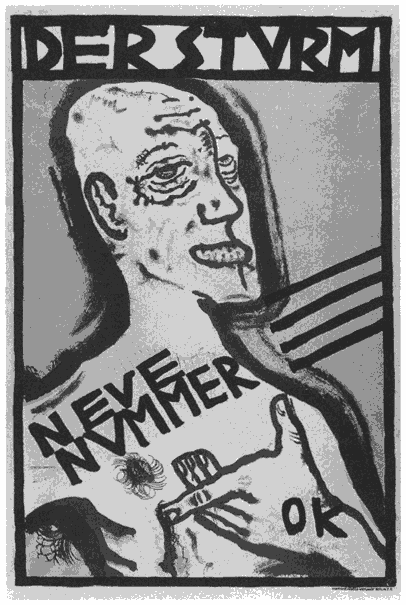
Fig. 23.
Oskar Kokoschka, Self-Portrait (Poster for Der Sturm ), 1910, lithograph poster. Courtesy Robert Gore Rifkind Collection, Beverly Hills.
77) becomes an icon of pure subjectivity, a subjectivity as independent in Schiele as it is in Michelstaedter. Moreover, as with Kokoschka, such encounters between "naked souls and naked destiny" are just strategies for Schiele to make his own self-encounter.
In 1910 he adds two other kinds of compositions to the subjective analyses of others: female nudes and self-portraits. Beginning with secret paintings of his younger sister Gerti, Schiele's nudes eventually include a whole repertoire of females, many prepubescent. Concurrent to the nudes, Schiele turns increasingly to depicting himself—scowling, screaming, gesticulating, naked, masturbating, and finally inviting or fending off death. While Schiele sometimes attaches allegorical depth to these self-representations, calling them The Lyric Poet, The Prophet, and so on, this is an attempt to ennoble or universalize the findings of what is primarily an exercise in self-perception. Whatever their names, all subjects are Schiele.
In these examinations of the only true topic of human experience—the nature of the solitary, subjective, desiring I—Schiele attains the peak of his art. The nakedness of his own body in his self-portraits suggests that the "erotic" female nudes are not an entirely separate issue: The effort to strip the other of clothes and the willingness to expose oneself are aspects of a single quest for the naked self. By penetrating the defenses of another, one attempts to penetrate one's own. The reflection on eros leads inevitably to a reflection on the I that is its source. In Schiele everything comes back to the desiring subject, to the narcissistic, onanistic seat of all shimmering interests of self. "I am for myself," he writes in his "Self-Portrait" of 1910, "and for those to whom my thirsty, drunken craving to be free gives everything, and also for all, for I love—I also love all. I am the noblest of the noble" (Schiele 1921: 19; Nebehay 1979: 142). In his self-portraits, the noblest of the noble gives all that he knows of himself to the world.
The most sensational of these offerings is the writhing, paralytic, agonized figure of the Nude Self-Portrait, Grimacing . On the surface the most striking thing about this self-portrait is its absolute refusal to let anything stand in the way of complete and pure self-perception. The self has decided that it must see how it looks naked, with no added distractions in front of the mirror. Like Zeus and his souls in the Isles of the Blessed, it has stripped off its "acquired characteristics" and confronted the reality that remains: a desperately feeling and thinking body, a self-confined self exposed to the world. Autoscopy could hardly prove more
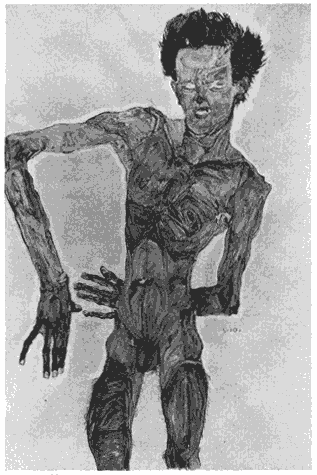
Fig. 24.
Egon Schiele, Nude Self-Portrait, Grimacing, 1910, pencil, watercolor, and
gouache. Courtesy Graphische Sammlung Albertina, Vienna.
troubling than it is in the portrait. Here the literally and painfully naked self is the only frame of reference for human experience, tortured against the void of a bad and empty infinity. The umbilicum, its original source of nourishment, is a hole. We, the ostensibly dispensable audience, are made privy to the delirium of he who looks too hard at himself, finding no selfsame person but only the actor of his role.
As though to reinforce the intent of these self-portraits, Schiele embarks in the same year on a series of "self-seer" compositions in which
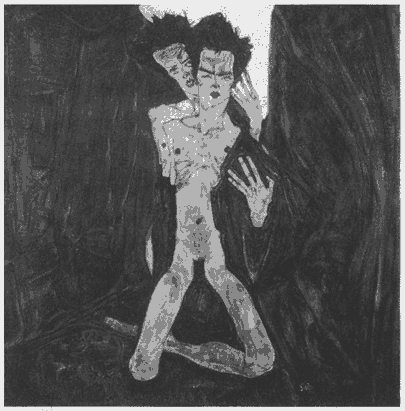
Fig. 25.
Egon Schiele, The Self-Seers I, 1910, oil. Courtesy Galerie St. Etienne, New York.
the topic is explicitly the self that looks at itself. More specifically, there are two selves in the paintings, each looking at the other in a mirror and yielding the plural Self-Seers of the title. The self has broken apart. In Self-Seers I we have two identical and easily recognizable Schieles, both naked, one kneeling behind the other and leaning out his head to observe the reflection of the other—or of himself in the company of his intimate other—in the mirror. The faces, bodies, and postures of each are nearly identical. One is the perceiving self, the other the self perceived. And the self perceived—the image contemplated in the mirror and committed to canvas, the I that is seen and known—is gripped by theatrical tension and subjective defiance. The implicit role of the mirror in this double portrait makes the existential connotations of such
self-reflection clear: The subject is caught in a narcissistic circle of interest that has no other outside it. The I communes with the I, a puppet-like entity that it seeks to prop up and bring into obeyance.
If self-knowledge or self-possession is the objective of this type of autoscopy, it fails as much here as in Michelstaedter. The seemingly closed circle of the self is broken even before it is drawn—broken in order to be drawn. Si duo idem faciunt non est idem, Michelstaedter writes: "if two make one, it is not one" (Michelstaedter 1983: 423). The effort to know oneself is hindered by the self-splitting by which it is enabled. Self-knowledge, like self-expression, is a double mediation of appearance, a double rhetoric of form, a seeing that is twice removed, a seeing of seeing. And this is, of course, an impossible dialectic. There is also the presence of the audience, for whom this self-view is performed. Positioned as the reflecting mirror, the audience is the mediating element that validates the "other" which the autoscopy seeks to exclude.
That self-mastery does not succeed in Schiele is suggested not only by the brutalization of the two aspects of the self in the subsequent self-seer portraits, but also by Schiele's permanent failure to represent a fully dignified, self-possessed subjectivity in his portraits. As the years progress (and there are only eight before Schiele dies of the Spanish fever in 1918), he moves beyond the self to depict landscapes and human relations. But never does the historical, empirical self come under the domination of an ideal, transcendent one. Instead, it remains hounded by the same impersonal forces it hoped to put to its purposes: artifice, libido, mortality, dumb feeling. The effort to discover self-rule ends in the way it began—in a scream, not addressed to the world, as in Munch, so much as to the self this world has abandoned.
Do Schoenberg and Kandinsky follow similar patterns? While advocating adventures in self-absorption which lead one to express "the nature of mankind," Schoenberg gives us the Red Gaze : a vision of subjectivity as sheer fright. He gives us encounters with that hypothetical situation in which the individual "is alone in the desert and must create everything by himself." He gives us the self-portrait of the Blue Rider Exhibition in 1912: the backside view of a slight, bald man walking wearily away from the frame. Above all he gives us the harmonies of dissonance—correlates, in Adorno's view, of a "lonely subjectivity which withdraws into itself," where voyaging home means entering "a vitreous no-man's-land in whose crystalline-lifeless air the seemingly transcendent subject . . . finds himself again on an imaginary plane" (Adorno 1985: 142). Coupled with his ontology of individual solitude, the frag-
mentations and contractions of free atonal music entail a reduction of the self into virtual silence (a silence which literally follows this phase of Schoenberg's music, not broken until he formulates the principles of serial composition nearly ten years later). That which is "inborn, instinctive," and literally unconscious cannot be conceived or grasped in a common, universal language. Schoenberg's ostensibly subjectivist art thus issues into an impersonal aesthetic. "Think what self-denial it takes to express oneself with such brevity," says Schoenberg of Webern's breathlessly short Six Bagatelles for String Quartet :
Every glance can be expanded into a poem, every sigh into a novel. But to express a novel with a single gesture, or a (person's) happiness with a single deep breath: such concentration is only to be found where there is a corresponding lack of self-pity. (Schoenberg 1992)
If this is an art of self-expression (and in Schoenberg's view it does intend to be), it is one that arises out of a virtual bereavement of language, aesthetics, and rhetoric. While Schoenberg views each of his compositions as "a self-portrait which should be presumed to bear a close resemblance to its creator" (Fleisher 1989: 22), the art to which this endeavor leads leaves no self behind. It issues into the very opposite of self-expression, a situation where
no Ego oversees and directs the operations of transformation and organization—no Subject who . . . might comprehend and dominate the [musical] material. . . . Where there is no Thing there cannot even be a Subject. (Cacciari 1982: 156)
The inevitable consequence of the quest for self-expression is the dissolution of subjectivity into pure composition, into a "necessary" form of rhetoric with neither everyday nor metaphysical cogency.
A similar process can be traced in the artist who most explicitly defends the value of the inward turn. After dividing experience into the two antithetical categories of spirit and matter, content and form, intention and expression, Kandinsky recommends that art devote itself to the first set of terms (of which form, material, and so on, are only the instruments). But this conception of art already transcends an aesthetics of the subject, at least if subjectivity is associated with the emotional or historical constitution of a living human being. Kandinsky has no use for psychological or physiological approaches to the self. This, indeed, is the basis for his criticism of the paintings of Kokoschka, Schoenberg, and the Brücke, which in his view used art for predominantly confessional purposes. The true content of art, Kandinsky writes, is "the
emotion in the soul of the artist" (Kandinsky 1910b: 87). And yet, this emotion is not the feeling of a person in a particular situation. Rather, it is a transpersonal "mood" in which all people can participate (Kandinsky 1914b: 403). "The birth of a work of art," he claims elsewhere, "is of cosmic character. The originator of the work is thus [not a particular artist but] the spirit. Thus, the work exists in abstracto prior to that embodiment which makes it accessible to the human senses" (Kandinsky 1914a: 394). If a work exists prior to its embodiment in form, its content transcends any given form of nature or historical experience. "As long as the soul remains joined to the body, it can as a rule only receive vibrations via the medium of the senses" (Kandinsky 1910b: 87); but in Kandinsky this soul is precisely what is not represented by the body—or by material and existential facts, by objective logic and philosophy, by historical and rhetorical form. The "true subject" is as transcendent here as the I in Husserl and Wittgenstein. It is not "in" the world; it is something that marks its borders, not a constituted form but an act of formal constitution, an "intention" exceeding expression.
The final nature of the I dissolves into something beyond the reach of all language and form. Its only form is one that it creates, and until it does so, this I or spirit can only be described in negative terms. "I do not want to paint states of mind. I do not want to paint coloristically or uncoloristically. . . . I do not want to show the future its path" (Kandinsky 1914a: 400). The absolute I is nothing that can be named before its forms have been invented. What lies beyond form can only be expressed by a form that is purified of empirical content: by shapes that are not representative, by unique new signs, by aesthetic surfaces not endowed with preestablished meanings. If the inner content of human experience is expressed by a form that is not recognizable (not "picturing" an entity or experience we can already conceive), the content is fully etherealized—no longer self but soul.
It is hard enough to experience spirit in everyday life, much less in the forms most proper to it: "The spirit is often concealed within matter to such an extent that few people are generally capable of perceiving it. Indeed, there are many people who are incapable of seeing the spirit even when incorporated in a spiritual form" (Kandinsky 1912a: 235). It is the second sentence that is crucial, for it suggests that there is such a spiritual form, an art of pure composition, of autonomous rhetoric without any criterion of evaluation. In practical terms, it takes an already cultivated audience to distinguish the "content" of a Kandinsky from the mere "formal exercises" of other types of painting. How can
the viewer tell whether a work embodies spiritual content or not? "Only its author can fully assess the caliber of a work of art" (Kandinsky 1910b: 87). An artistic procedure "is only and exclusively good, properly speaking, if it has come of its own accord" (Kandinsky 1914a: 394). But no such judgment can be confidently made by someone outside the creative process. Indeed, as many conservative critics of art have charged throughout our century, objective criteria for the "aesthetically good" are in a very real sense made obsolete by the work of Kandinsky and Schoenberg. Such criteria can only be re-created by each work anew, each on its own individual terms. No work can be properly read until and unless its hidden, internal mechanisms are discovered.
After Schoenberg and Kandinsky, the aesthetic validity of a work no longer lies in any self-evident subject—for here such a subject is no longer self-evident, and does not even exist before the work—but only in the communicative lines that it establishes with its audience, in the relationship that it instills between audience and artist. And this changes the very notion of a work's "inner necessity." Now this necessity is present only where "the vibration in the soul of the artist [finds] a material form, a means of expression, which is capable of being picked up by the receiver" (Kandinsky 1910b: 87). The choice of colors, forms, and subject matter in painting "can only be based on the principle of purposefully touching the human soul . This basic tenet we shall call the principle of internal necessity " (Kandinsky 1909–11: 160; cf. 165 and 169). The innerness or content of art thus lies outside it, in the activity it engenders in human beings, in the manner of Buber's moments of "heightened experience," where no subject confronts an object, but rather a significant occurrence absorbs them both in its flow. By pursuing a spirituality that can withstand the deficiency of being, Kandinsky abolishes the subject standing over and against the object in at least three ways: He makes it fully abstract (i.e., not reducible to a concrete, historical self); he dissolves its content into form; and he notes that even this form cannot be understood as a "sign" for a content, but only as the medium of a hermeneutical activity in which that content occurs . Less than anyone else can the artist say "I."
Thus Schoenberg and Kandinsky duplicate the path of Schiele, Kokoschka, and Michelstaedter. The soul, not the self, is their true subject of interest and knowledge. Yet this most "intrinsic" of realities, this "noumenon" contrasted with all phenomena, is no longer intrinsic or self-contained. The gaze inward yields nothing but the process of gazing, not focused on any fixed subject or object.
After these prewar attempts to give form to soul, the very notion of the soul is lost. It naturally and inevitably erases itself, living on, at best, as a name for its absence, as an announcement of the definitive impossibility of possessing a language for what is most real.[15] Innerness, subjectivity, persuasion, individualism, and the self—by dint of the effort to discover their nature (or to accomplish the goal of Western humanism)—lose their meaning. After the expressionists, artists no longer even believe in self-constituting realms of subjectivity. Futurism, imagism, dadaism, and surrealism—not to mention the emotional outcries of postwar expressionism and irrational new arts of the id—wittingly or unwittingly espouse the end of the I as "the measure of all things." All this replicates the catastrophe of collective and historical self-determination in the Great War of 1914. Believing that their action was self-determining, the warring powers discovered instead that the selves and the passions they were serving were almost totally at the mercy of outside forces. Bent on controlling its own destiny, each national or ethnic group was forced to recognize that such destiny was a thoroughly contextual matter. The world of victors and vanquished alike was one in which Michelstaedter's principles of dependent, rhetorical, and correlative existence were more real and intractable than all self-governing dreams.
The great pathos of prewar expressionist art thus lies in its pursuing a Western ideal to the point where it collapses in exhaustion. As Kandinsky puts it, "the seeds of the struggle toward . . . inner nature . . . obey the words of Socrates: 'Know thyself!'" (Kandinsky 1909–11: 153). The ideal of self-expression appears predicated upon the possibility of self-knowledge, but this, in turn, relies on a belief in the self. One can
[15] The most eloquent postwar descriptions of this unliving "center" of subjective experience are achieved (in negative terms) by Robert Musil's The Man Without Qualities . Having established that every person has at least nine selves or characters (national, sexual, unconscious, etc.), the narrator of the novel concludes that "every inhabitant of the earth also has a tenth character that is nothing else than the passive fantasy of spaces yet unfilled." The true essence of a person, or the only innerness that is not contingent, now appears to be this empty space (or better, this illusion of an empty space). "Whether one is at rest or in motion, what matters is not what lies ahead, what one sees, hears, wants, takes, masters. . . . Something is not quite in balance, and a person presses forward, like a tightrope walker, in order not to sway and fall. And as he presses on through life and leaves lived life behind, the life ahead and the life already lived form a wall, and his path in the end resembles the path of a woodworm: no matter how it corkscrews forward or even backward, it always leaves an empty space behind it. And this horrible feeling of a blind, cutoff space behind the fullness of everything, this half that is always missing even when everything is a whole, this is what eventually makes one perceive what one calls the soul" (Musil 1930–40: vol. 1, chaps. 8 and 45).
express oneself only if one (a) possesses such a self, (b) is properly attuned to it, and (c) gives it a convincing form. In the period separating Socrates from twentieth-century vitalism these principles encounter no absolutely insuperable obstacles. The problems arise when everything appears to hinge on these principles and them alone. At the height of its cultural appeal, self-expression begins to look like an ideal but unreal plan. There no longer exists any measure for the "measure of all things." Subjectivity, the only true content of objective experlence, proves to be the ultimate bastion of otherness, the absolutely self-alienated object. The ideal of self-expression leads directly to suicide.
But in this death begin ethics and aesthetics.